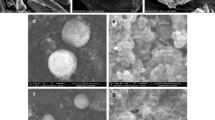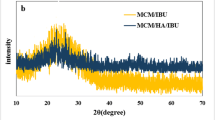Abstract
The purpose of the present study was characterization of microparticles obtained by adsorption of poorly water soluble drug, meloxicam, on a porous silicate carrier Florite RE (FLR) and development of a tablet formulation using these microparticles, with improved drug dissolution properties. The study also reveals the use of FLR as a pharmaceutical excipient. Meloxicam was adsorbed on the FLR in 2 proportions (1∶1 and 1∶3), by fast evaporation of solvent from drug solution containing dispersed FLR. Drug adsorbed FLR microparticles were evaluated for surface topography, thermal analysis, X-ray diffraction properties, infrared spectrum, residual solvent, micromeritic properties, drug content, solubility, and dissolution studies. Microparticles showed bulk density in the range of 0.10 to 0.12 g/cm3. Dissolution of drug from microparticles containing 1∶3, drug∶FLR ratio was faster than microparticles containing 1∶1, drug∶FLR ratio. These microparticles were used for formulating directly compressible tablets. Prepared tablets were compared with a commercial tablet. All the prepared tablets showed acceptable mechanical properties. Disintegration time of prepared tablets was in the range of 18 to 38 seconds, and drug dissolution was much faster in both acidic and basic medium from prepared tablets as compared with commercial tablet. The results suggest that FLR provides a large surface area for drug adsorption and also that a reduction in crystallinity of drug occurs. Increase in surface area and reduction in drug crystallinity result in improved drug dissolution from microparticles.
Similar content being viewed by others
References
Amidon GL, Lennernäs H, Shah VP, Crison JR. A theoretical basis for a biopharmaceutic drug classification: the correlation of in vitro drug product dissolution and in vivo bioavailability.Pharm Res. 1995; 12:413–420.
Meriani F, Coceani N, Sirotti C, Voinovich D, Grassi M. In vitro nimesulide absorption from different formulations.J Pharm Sci. 2004;93:540–552.
Perrut M, Jung J, Leboeuf F. Enhancement of dissolution rate of poorly-soluble active ingredients by supercritical fluid processes Part I. Micronization of neat particles.Int J Pharm. 2005;288:3–10.
Kinoshita M, Baba K, Nagayasu A, et al. Improvement of solubility and oral bioavailability of a poorly water-soluble drug, TAS-301, by its melt-adsorption on a porous calcium silicate.J Pharm Sci. 2002; 91:362–370.
Ambike AA, Mahadik KR, Paradkar A. Stability study of amorphous valdecoxib.Int J Pharm. 2004;282:151–162.
Chowdary KPR, Hymavathi R. Enhancement of dissolution rate of meloxicam.Ind J Pharm Sci. 2001;63:150–154.
Smirnova I, Suttiruengwong S, Seiler M, Arlt W. Dissolution rate enhancement by adsorption of poorly soluble drugs on hydrophilic silica aerogels.Pharm Dev Technol. 2004;9:443–452.
Streubel A, Siepmann J, Bodmeier R. Floating matrix tablet based on low density foam powder: effects of formulation and processing parameters on drug release.Eur J Pharm Sci. 2003;18:37–45.
Yuasa H, Takashima Y, Kanaya Y. Studies on the development of intragastric floating and sustained release preparation. I. Application of calcium silicate as a floating carrier.Chem Pharm Bull (Tokyo). 1996;44:1361–1366.
Streubel A, Siepmann J, Bodmeier R. Floating microparticles based on low density foam powder.Int J Pharm. 2002;241:279–292.
Ito Y, Arai H, Uchino K, Iwasaki K, Shibata N, Takada K. Effect of adsorbents on the absorption of lansoprazole with surfactant.Int J Pharm. 2005;289:69–77.
Salis A, Sanjust E, Solinas V, Monduzzi M. Characterization of Accurel MP 1004 polypropylene powder and its use as a support for lipase immobilization.J Mol Cat B Enz. 2003;24–25:75–82.
Byrne RS, Deasy PB. Use of commercial porous ceramic particles for sustained drug delivery.Int J Pharm. 2002;246:61–73.
Yuasa H, Asahi D, Takashima Y, Kanaya Y, Shinozawa K. Application of calcium silicate for medicinal preparation. I. Solid preparation adsorbing an oily medicine to calcium silicate.Chem Pharm Bull (Tokyo). 1994;42:2327–2331.
Yuasa H, Akutagawa M, Hashizume T, Kanaya Y. Studies on internal structure of tablets. VI. Stress dispersion in tablets by excipients.Chem Pharm Bull (Tokyo). 1996;44:378–382.
Kinoshita M, Baba K, Nagayasu A, et al. Highly stabilized amorphous 3-bis(4-methoxyphenyl)methylene-2-indolinone (TAS-301) in melt-adsorbed products with silicate compounds.Drug Dev Ind Pharm. 2003;29:523–529.
Jackson RL, Jason MD. Analgesic-antipyretic and anti-inflammatory agents and drugs employed in the treatment of gout. In: Hardman JG, Limbird LE, eds.Goodman & Gilman’s The Pharmacological Basis of Therapeutics. New York, NY: McGraw-Hill; 2000:713–714.
Naidu NB, Chowdary KP, Murthy KV, Satyanarayana V, Hayman AR, Becket G. Physicochemical characterization and dissolution properties of meloxicam-cyclodextrin binary systems.J Pharm Biomed Anal. 2004;35:75–86.
Ghorab MM, Abdel-Salem HM, El-Sayad MA, Mekhel MM. Tablet formulation containing meloxicam and β-cyclodextrin: mechanical characterization and bioavailability evaluation.AAPS PharmSciTech. 2004;5:E59.
Seedher N, Bhatia S. Solubility enhancement of Cox-2 inhibitors using various solvent systems.AAPS PharmSciTech. 2003;4:E33.
Cantera RG, Leza MG, Bachiller CM. Solid phases of tenoxicam.J Pharm Sci. 2002;91:2240–2251.
International Conference on Harmonization of Technical Requirements for Registration of Pharmaceuticals for Human Use.ICH Harmonised Tripartite Guideline. Impurities: guideline for residual solvents Q3C. Geneva, Switzerland: ICH; 1997.
Costa P, Lobo JMS. Modeling and comparison of dissolution profiles.Eur J Pharm Sci. 2001;13:123–133.
Charumanee S, Okonoki S, Sirithunyalug J. Improvement of the dissolution rate of piroxicam by surface solid dispersion.CMU J. 2004;3:77–84.
Author information
Authors and Affiliations
Corresponding author
Additional information
Published: December 7, 2005
Rights and permissions
About this article
Cite this article
Sharma, S., Sher, P., Badve, S. et al. Adsorption of meloxicam on porous calcium silicate: Characterization and tablet formulation. AAPS PharmSciTech 6, 76 (2005). https://doi.org/10.1208/pt060476
Received:
Accepted:
DOI: https://doi.org/10.1208/pt060476




